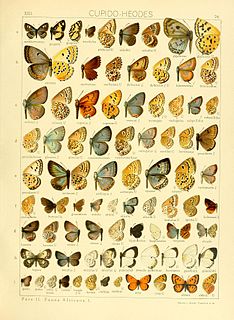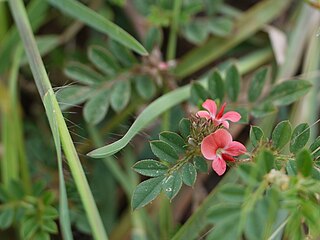External links
| | This Betaproteobacteria-related article is a stub. You can help Wikipedia by expanding it. |
| Vogesella indigofera | |
|---|---|
| Scientific classification | |
| Kingdom: | |
| Phylum: | |
| Class: | Beta Proteobacteria |
| Order: | |
| Family: | |
| Genus: | Vogesella Grimes et al. 1997 |
| Binomial name | |
| Vogesella indigofera (Voges 1893) Grimes et al. 1997 | |
| Synonyms | |
Bacillus indigoferusVoges 1893 | |
Vogesella indigofera is a strictly aerobic, Gram-negative bacterium. It is the sole species of the genus Vogesella. V. indigofera produces a blue pigment (indigoidine)and the colonies develop a metallic copper sheen upon extended incubation (greater than 24 hours). This organism is not known to be pathogenic and is commonly found in freshwater.
| | This Betaproteobacteria-related article is a stub. You can help Wikipedia by expanding it. |

Indigo dye is an organic compound with a distinctive blue color. Historically, indigo was a natural dye extracted from the leaves of some plants of the Indigofera genus, in particular Indigofera tinctoria; dye wielding Indigofera plants were commonly grown and used throughout the world, in Asia in particular, as an important crop, with the production of indigo dyestuff economically important due to the previous rarity of some blue dyestuffs historically.

Indigofera is a large genus of over 750 species of flowering plants belonging to the pea family Fabaceae. They are widely distributed throughout the tropical and subtropical regions of the world.

Indigofera tinctoria, also called true indigo, is a species of plant from the bean family that was one of the original sources of indigo dye. It has been naturalized to tropical and temperate Asia, as well as parts of Africa, but its native habitat is unknown since it has been in cultivation worldwide for many centuries. Today most dye is synthetic, but natural dye from I. tinctoria is still available, marketed as natural coloring where it is known as tarum in Indonesia and nila in Malaysia. In Iran and areas of the former Soviet Union it is known as basma. The plant is also widely grown as a soil-improving groundcover.

Indigofera suffruticosa, commonly known as Guatemalan indigo, small-leaved indigo, West Indian indigo, wild indigo, and anil, is a flowering plant in the pea family, Fabaceae.

Persicaria tinctoria is a species of flowering plant in the buckwheat family. Common names include Chinese indigo and Japanese indigo. It is native to Eastern Europe and Asia.
Indigofera marmorata is a species of legume in the family Fabaceae. It is found only in Yemen. Its natural habitats are subtropical or tropical dry forests and subtropical or tropical dry shrubland.
Indigofera rothii is a species of legume in the family Fabaceae. It is found only in Ethiopia.
Indigofera sokotrana is a species of legume in the family Fabaceae. It is found only in Yemen. Its natural habitat is subtropical or tropical dry forests.
(Orachrysops ariadne), the Karkloof blue, is a species of butterfly in the family Lycaenidae.
Tillandsia indigofera is a species of plant in the family Bromeliaceae. It is endemic to Ecuador. Its natural habitat is subtropical or tropical dry shrubland.
César Barbosa is a Colombian biologist, ornithologist and botanist, specialising in the study of Fabaceae.

Indigofera australis, the Australian indigo or Austral indigo, is an attractive species of leguminous shrub in the genus Indigofera. The genus name Indigofera is Neo-Latin for "bearing Indigo". Australis, from the Latin, means not “Australian” but "southern", referring to the geographical distribution of the species.
Foliata, a Latin word meaning leafy, may refer to:

Zizina antanossa, the dark grass blue or clover blue, is a butterfly of the family Lycaenidae. It is found in all of Africa, including Madagascar and Réunion.
Pendhā was an intoxicating beverage, originating from the Indian subcontinent, made by the Pindari community of mercenaries in central India in the 18th and 19th centuries, and possibly the etymological origin or the group's name. The drink was said to have been made by fermenting sorghum (jowār), or possible Indigofera linifolia.

Indigofera heterantha, commonly known as Himalayan indigo, is a species of flowering plant in the legume family Fabaceae. It is native to the northwestern Himalayas of Tibet, in Asia.

Indigofera linnaei, known as Birdsville indigo and nine-leaved indigo, is a species of leguminous shrub in the genus Indigofera. The genus name, Indigofera, is derived from Latin and means bearing/containing indigo, while linnaei derives from Linnaeus.

Indigofera decora, commonly known as summer wisteria, is a species of shrub native to China and Japan. A member of the genus Indigofera, its family is Fabaceae and is used primarily for decorative purposes.

Indogofera astragalina, a legume also known as silky indigo, is a herb found in India, tropical Africa, Madagascar, New Guinea and Australia. It commonly grows in sandy or rocky soils in dry deciduous forests or along roadsides and lake margins. It is also cultivated.